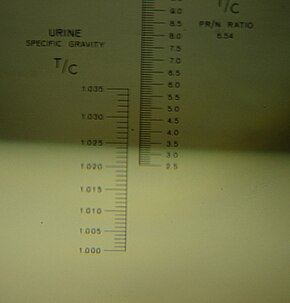Urine specific gravity
| Urine specific gravity | |
|---|---|
 Reading of a urine specific gravity of ~1.024 via a handheld refractometer. SG measurement is taken by reading the boundary between the dark and light fields against the graduations on the left column. | |
| Purpose | evaluation of kidney function |
Specific gravity, in the context of
renal diseases
.
Background
One of the main roles of the
specific gravity
. In adult humans, normal specific gravity values range from 1.010 to 1.030.
Specific gravity and disease
Adults generally have a specific gravity in the range of 1.010 to 1.030. Increases in specific gravity (hypersthenuria, i.e. increased concentration of solutes in the urine) may be associated with
Hypovolemic
patients usually have a specific gravity >1.015.
Decreased specific gravity (hyposthenuria, i.e. decreased concentration of solutes in urine) may be associated with
Osmolality is normally used for more detailed analysis, but USG remains popular for its convenience.[5]
References
- ^ Explanation of Hepatorenal Syndrome on MedlinePlus
- PMID 9841955.
- ^ Explanation of Acute Tubular Necrosis on MedlinePlus
- ^ Explanation of Interstitial Nephritis on MedlinePlus
- ^ "Urine specific gravity". MedlinePlus : U.S. National Library of Medicine. Retrieved 31 May 2013.
